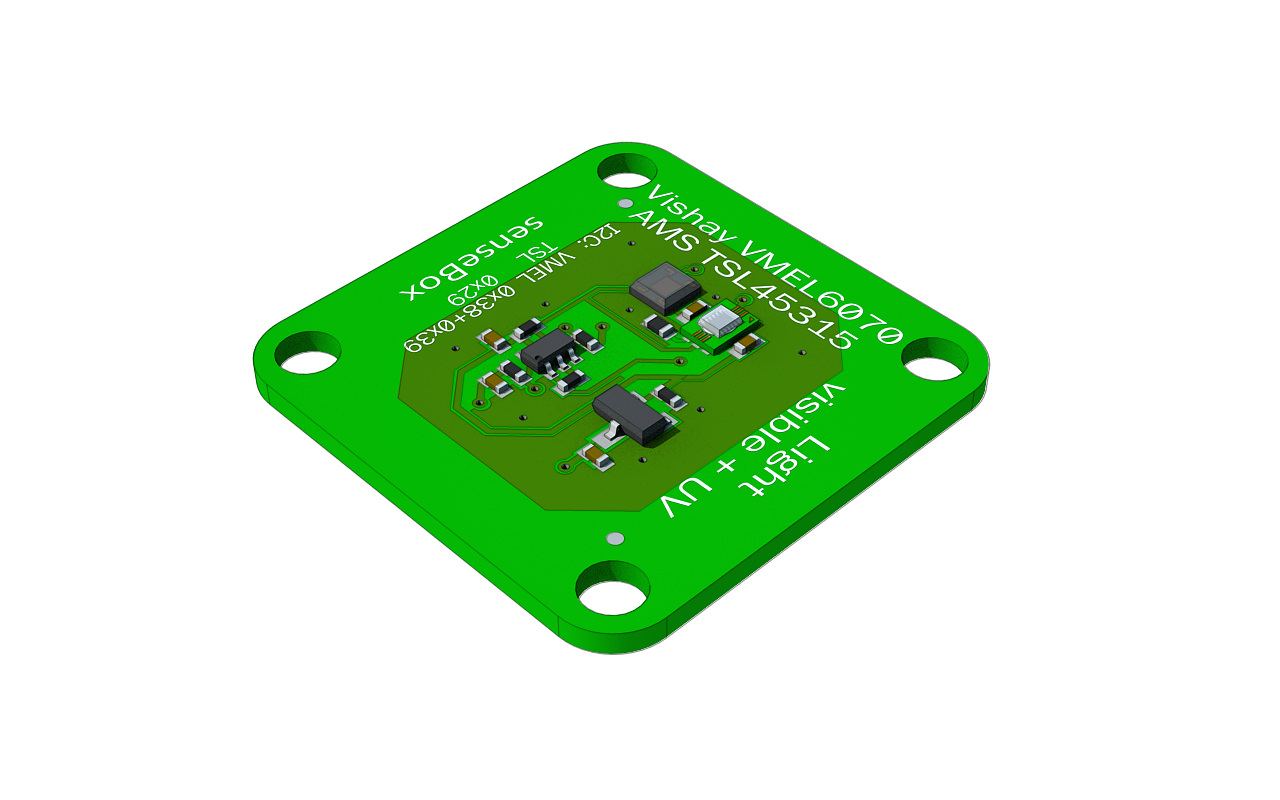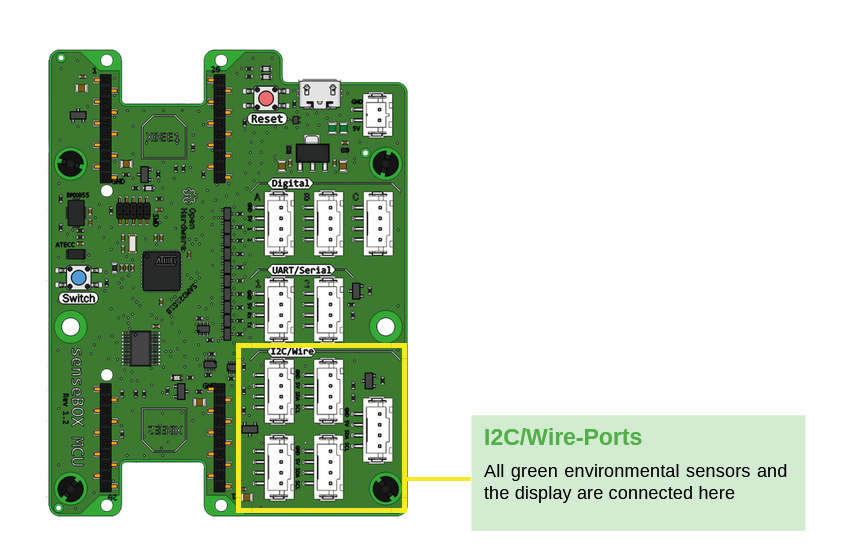Brightness and UV Sensor
On this senseBox component, two sensors are combined.
The light intensity is measured with the TSL45315 sensor from AMS-TAOS or the LiteOn LTR329ALS-01 sensor (since 02/21). This sensor detects the light conditions similar to the human eye and outputs the brightness values directly in Lux, with a large dynamic range (3 Lux to 220k Lux).
The second sensor is a Vishay VEML6070 Ultraviolet (UV) light sensor. This sensor converts the intensity of the sun's UV light into digital data. The sensor has excellent UV sensitivity and linearity over Filtron™ technology. It has good UV radiation measurement even with long sun UV exposure and can excellently compensate for temperature fluctuations.

Brightness and UV Sensor
Technical Information
Light Meter
- 3.3V - 5V tolerant I2C/TWI interface
- Input voltage range: 3.3V - 5V
- On-board 2.5V voltage regulator
- On-board level shifter
UV Sensor
- Operating voltage: 2.7V - 5.5V I2C interface
- Supports acknowledgment function (Active Acknowledge function)
- Temperature compensation: -40°C to +85°C
- Software shutdown control for immunity to flickering fluorescent lights
Dimensions
- 25mm x 25mm x 9mm
- Weight: 2.5 g
Connection

The component is connected to the I2C port.
Programmierung (Arduino)
Software Library
To program the sensor in Arduino, you need to install the software libraries Adafruit LTR329 and LTR303 and Adafruit VEML6070 Library.
Code
This code outputs the values for Lux and UV intensity in the Serial Monitor
#include <SPI.h>
#include <LTR329.h>
#include <Wire.h>
#include <VEML6070.h>
bool lightsensortype = 0; //0 for tsl - 1 for ltr
//settings for LTR sensor
LTR329 LTR;
unsigned char gain = 1;
unsigned char integrationTime = 0;
unsigned char measurementRate = 3;
VEML6070 veml;
int read_reg(byte address, uint8_t reg)
{
int i = 0;
Wire.beginTransmission(address);
Wire.write(reg);
Wire.endTransmission();
Wire.requestFrom((uint8_t)address, (uint8_t)1);
delay(1);
if(Wire.available())
i = Wire.read();
return i;
}
void write_reg(byte address, uint8_t reg, uint8_t val)
{
Wire.beginTransmission(address);
Wire.write(reg);
Wire.write(val);
Wire.endTransmission();
}
void Lightsensor_begin()
{
Wire.begin();
unsigned int u = 0;
u = read_reg(0x29, 0x80 | 0x0A); //id register
if ((u & 0xF0) == 0xA0) // TSL45315
{
write_reg(0x29, 0x80 | 0x00, 0x03); //control: power on
write_reg(0x29, 0x80 | 0x01, 0x02); //config: M=4 T=100ms
delay(120);
lightsensortype = 0; //TSL45315
}
else
{
LTR.begin();
LTR.setControl(gain, false, false);
LTR.setMeasurementRate(integrationTime, measurementRate);
LTR.setPowerUp(); //power on with default settings
delay(10); //Wait 10 ms (max) - wakeup time from standby
lightsensortype = 1; //
}
}
unsigned int Lightsensor_getIlluminance()
{
unsigned int lux = 0;
if (lightsensortype == 0) // TSL45315
{
unsigned int u = (read_reg(0x29, 0x80 | 0x04) << 0); //data low
u |= (read_reg(0x29, 0x80 | 0x05) << 8); //data high
lux = u * 4; // calc lux with M=4 and T=100ms
}
else if (lightsensortype == 1) //LTR-329ALS-01
{
delay(100);
unsigned int data0, data1;
for (int i = 0; i < 5; i++) {
if (LTR.getData(data0, data1)) {
if(LTR.getLux(gain, integrationTime, data0, data1, lux));
if(lux > 0) break;
else delay(10);
}
else {
byte error = LTR.getError();
}
}
}
return lux;
}
void setup() {
Serial.begin(9600);
Lightsensor_begin();
veml.begin();
}
void loop() {
Serial.print("Illuminance: ");
Serial.println(ightsensor_getIlluminance());
Serial.print("UV-Intensity: ");
Serial.println(veml.getUV());
}
Programming (Blockly)
In Blockly, the sensor can be read using the following block:
In the block, you can select between the different parameters of the brightness/UV sensor:
- Brightness in LUX
- UV exposure in µW/cm^2
